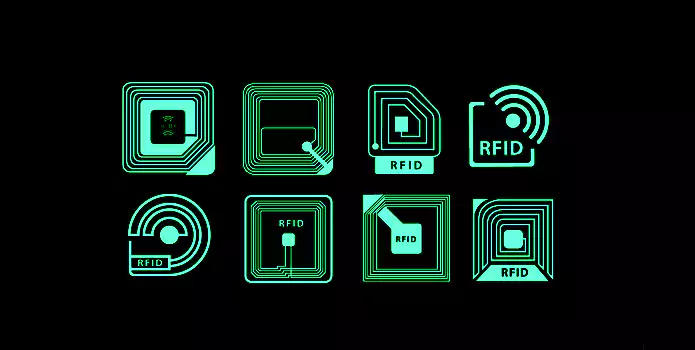Introduction
Many people are both curious and unfamiliar with RFID. Today, let me show you a systematic understanding of RFID. This guide is ideal for those new to RFID and who want to learn about what the technology is, how it is used, about the different types, and about the necessary tags and equipment.
What is RFID?
RFID is an acronym for “radio-frequency identification” and refers to a technology whereby digital data encoded in RFID tags or smart labels (defined below) are captured by a reader via radio waves. RFID is similar to barcoding in that data from a tag or label are captured by a device that stores the data in a database. RFID, however, has several advantages over systems that use barcode asset tracking software. The most notable is that RFID tag data can be read outside the line-of-sight, whereas barcodes must be aligned with an optical scanner.
How does RFID work?
Radio Frequency Identification (RFID) is the wireless non-contact use of radio frequency waves to transfer data. Tagging items with RFID tags allows users to automatically and uniquely identify and track inventory and assets. RFID takes auto-ID technology to the next level by allowing tags to be read without a line of sight and, depending on the type of RFID, having a read range between a few centimeters to over 20+ meters.
RFID has come a long way from its first application of identifying airplanes as friend or foe in World War II. Not only does the technology continue to improve year over year, but the cost of implementing and using an RFID system continues to decrease, making RFID more cost-effective and efficient.
The main features of RFID
- Able to Read and Write data without direct contact The RF tag can contain up to several kilobytes of rich information. All of the data required for each process (process history, inspection history, etc) can be freely stored, without the need for direct contact. This makes it possible to develop paperless sites, where the causes of production stops are reduced.
- By “combining an item with its information”, a highly pliable and reliable system configuration becomes possible With the technology to decentralize information, the load on higher systems is reduced. This means that system development costs can also be reduced, systems can be implemented significantly faster, and the system is much more flexible when making changes. Also, “the unification of items with their information” for each process and site can make it possible to manage production/processes and product quality without errors. And, with the latest information contained in RF tags, work can continue offline in emergencies, significantly shortening the time required to restore processes.
- With the adoption of space transmission technology and protocols, highly reliable communication is made possible As opposed to barcodes which simply look for 1 or 0, advanced space transmission technologies and specialized protocols are employed for transmission through the air. 16 bits CRC is added to the information as it is transmitted. More than 18 bits of Burst errors can be detected at a ratio of 00.9985%, providing very high reliability in the transfer. Also, since there are no mechanical devices involved such as with the Raster Scan method for barcodes, the likelihood of malfunction and other problems is greatly reduced.
- Reading and writing is possible without a line of sight, using electric and electromagnetic wave transmission 1., Unlike barcodes, since communication occurs by means of electric and electromagnetic waves, erroneous readings due to dirt, moisture, oil, etc are canceled out. Even if there is dust, moisture, etc., or anything other than metal between the antenna and the RF tag,. it will not affect transmission. And since the communication range is wide, there is no need for extreme positioning which can greatly reduce the time and cost of design.
- Can simultaneously access information of multiple RF tags Some RFID systems are equipped with a function that allows you to simultaneously read the information of multiple RF tags existing within the transmissions area of the Reader/Writer.
What is the read range for RFID tag?
There really is no such thing as a “typical” RFID tag, and the read range depends on whether the tag is active or passive. Active tags broadcast a signal, so they have a much longer read range—300 feet or more—than passive tags. The read range of passive tags depends on many factors: the frequency of operation, the power of the reader, interference from other RF devices, and so on. In general, low-frequency and high-frequency tags are read from within three feet (1 meter) and UHF tags are read from 10 to 20 feet. Readers with phased array antennas can increase the read range of passive tags to 60 feet or more.
How much information can an RFID tag store?
In other automatic identification technology varieties, the maximum amount of data capacity can only store 2,725 numbers. If the letter is included, the storage amount will be less. The RFID label storage capacity is 2 to the 94th power (nearly 10,000 Bytes), which completely abandons the various restrictions of the barcode so that every object in the world is different. Have a unique identifier.
But typically a tag carries no more than 2 kilobytes (KB) of data—enough to store some basic information about the item it is on. Simple “license plate” tags contain only a 96-bit or 128-bit serial number. The simple tags are cheaper to manufacture and are more useful for applications where the tag will be disposed of with the product packaging. The aerospace industry wants to store parts histories on high memory tags, which has led to the introduction of passive UHF tags that store 4KB or 8KB of data.
What about RFID Energy?
The active RFID tag is supplied by the built-in battery, and different tags use different quantities and shapes of batteries. The passive RFID tag is not included in the battery, and its power is obtained from the RFID reader. When passive RFID tags are close to the RFID reader, the antenna of the passive RFID tag converts the received electromagnetic wave energy into electrical energy, activates the chip in the RFID tag, and transmits the data in the RFID chip.
RFID Communication Protocol
RFID standards and protocols are the basis of RFID chip design. At present, the common international RFID standards and protocols are ISO/IEC 18000, ISO11784, ISO11785, ISO/IEC 14443, ISO/IEC 15693, etc.
ISO/IEC 18000-1:2008: Information technology — Radio frequency identification for item management — Part 1: Reference architecture and definition of parameters to be standardized
ISO/IEC 18000-2:2009: Information technology — Radio frequency identification for item management — Part 2: Parameters for air interface communications below 135 kHz
ISO/IEC 18000-3:2010: Information technology — Radio frequency identification for item management — Part 3: Parameters for air interface communications at 13,56 MHz
ISO/IEC 18000-4:2018: Information technology — Radio frequency identification for item management — Part 4: Parameters for air interface communications at 2,45 GHz
ISO/IEC 18000-6:2013: Information technology — Radio frequency identification for item management — Part 6: Parameters for air interface communications at 860 MHz to 960 MHz General
ISO/IEC 18000-7:2014: Information technology — Radio frequency identification for item management — Part 7: Parameters for active air interface communications at 433 MHz
ISO/IEC 14443-3:2016: Identification cards — Contactless integrated circuit cards — Proximity cards — Part 3: Initialization and anticollision
ISO/IEC 15693-3:2019: Cards and security devices for personal identification — Contactless vicinity objects — Part 3: Anticollision and transmission protocol
ISO 11784:1996: Radio frequency identification of animals — Code structure
ISO 11785:1996: Radio frequency identification of animals — Technical concept
ISO 14223-1:2011: Radiofrequency identification of animals — Advanced transponders — Part 1: Air interface
ISO 14223-2:2010: Radiofrequency identification of animals — Advanced transponders — Part 2: Code and command structure
TYPES OF RFID
Within the Electromagnetic Spectrum, there are three primary frequency ranges used for RFID transmissions – Low Frequency, High Frequency, and Ultra-High Frequency.
LOW FREQUENCY
The Low Frequency, or LF band, is between 30 kHz and 300 kHz with long wavelengths of around 2,400 meters. Because there are multiple types of signals communicating on this band, LF RFID systems are only allowed to use the small range between 125 – 134 kHz. The large wave size allows LF waves to penetrate metal and water which is unique to this frequency band.
- General Frequency Range:30 – 300 KHz
- Primary Frequency Range:125 – 134 KHz
- Read Range: Contact – 10 Centimeters
- Average Cost Per Tag: $0.08 – $5.00
- Applications: Animal tracking, access control, car key-fob, applications with high volumes o liquids and metals
- Pros: Works well near liquids & metals, Global Standards
- Cons: Very short read range, a limited quantity of memory, low data transmission rate, high production cost
High FREQUENCY
The high frequency (HF) band on the RF spectrum extends from 3 MHz to 30 MHz. The wavelength of a high-frequency wave is much shorter than an LF wave – only around 22 meters, or a little less than 2 school buses in length. High frequency, like low frequency, uses magnetic coupling to communicate between the tags and the RFID reader/antenna. HF waves can pass through most materials except for water and dense metals. Thin metals, like aluminum, can still be tagged with HF tags and function normally.
- Primary Frequency Range: 13.56MHz
- Read Range: Near Contact – 30 Centimeters
- Average Cost Per Tag: $0.08 – $10.00
- Applications: Access control, Anti-counterfeiting, DVD kiosks, library books, personal ID cards, poker/gaming chips, NFC applications, etc.
- Pros: NFC global protocols, larger, memory options, High safety performance, global standards
- Cons: Short read range, low data transmission rate
Ultra-High Frequency
The ultra-high frequency (UHF) band within the RF spectrum ranges from 300 MHz to 3 GHz; however, most UHF RFID systems operate between the 860 – 960 MHz bands. The primary exceptions are RFID systems that operate at 433 MHz and 2.45 GHz.
- General Frequency Range: 300 – 3000 MHz
- Primary Frequency Range: 433 MHz, 860 – 960 MHz
- Average Cost Per Tag: $0.06 – $10.00
- Applications: Asset management, production line management, supply chain management, warehousing, all kinds of items anti-counterfeiting source (such as tobacco, alcohol, medicine, etc.), retail, vehicle management, etc.
- Pros: Read multiple labels at one time, identify the distance far, fast delivery, high reliability, and uses.
- Cons: Works bad near liquids & metals, it is necessary to customize the label according to a specific environment
Related Articles
- A Beginner’s Guide – What Is An NFC Tag?
- Top 15 Benefits Of Using RFID For Events
- How To Buy RFID Tags – An All-Inclusive RFID Tag Buying Guide
- Learn All About Different Types Of RFID Tags
- LF, HF, And UHF Frequency: What’s The Difference?
- RFID VS Barcode: Which One Is Better For Your System?
- Unique Features And Benefits Of Custom RFID Tags
- Here’s Everything You Want To Know About RFID Tags
- Music Festival RFID Bracelets Make Management Easier


